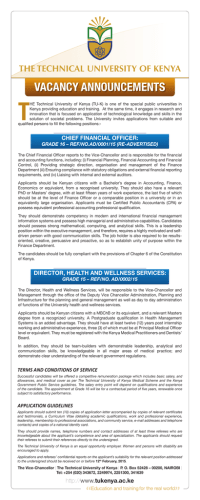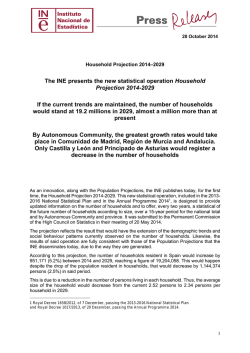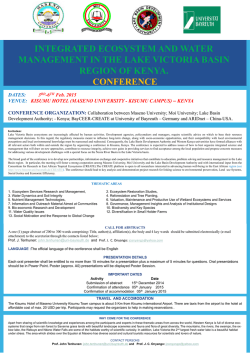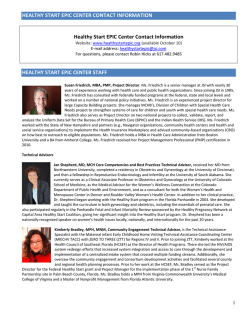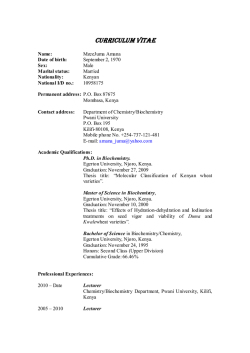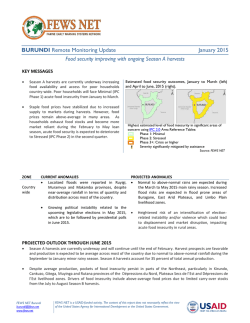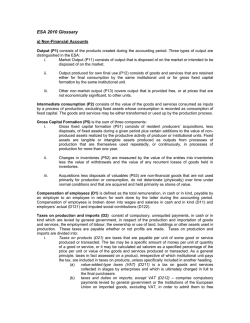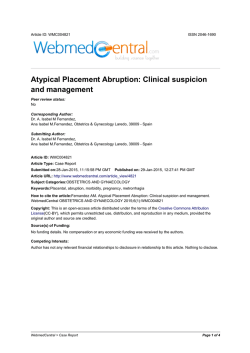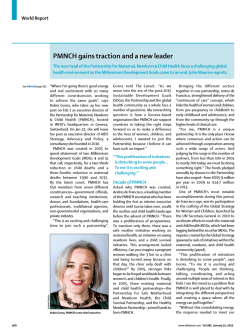
Socio-Demographic Factors Influencing Maternal and Child Health
American Journal of Public Health Research, 2015, Vol. 3, No. 1, 21-30 Available online at http://pubs.sciepub.com/ajphr/3/1/4 © Science and Education Publishing DOI:10.12691/ajphr-3-1-4 Socio-Demographic Factors Influencing Maternal and Child Health Service Utilization in Mwingi; A Rural Semi-Arid District in Kenya Japheth M. Nzioki1, Rosebella O. Onyango2, James H. Ombaka3,* 1 Department of Environmental Health, University of Kabianga, Kericho, Kenya 2 Department of Public Health, Maseno University, Kisumu , Kenya 3 Department of Biomedical Sciences and Technology, Maseno University, Kisumu, Kenya *Corresponding author: [email protected] Received January 02, 2015; Revised January 20, 2015; Accepted February 01, 2015 Abstract By the end of this year (2015), Kenya is expected to meet the targets of Millennium Development Goals number 4 and 5 among others. Available evidence suggests that utilization of Maternal and Child Health services is critical in realization of these goals. The aim of this study was to explore the socio-demographic factors influencing Maternal and Child Health service utilization in Mwingi district. This was a descriptive cross-sectional study. Data was collected from a sample of 416 women. Variables of interest were; socio-demographic variables and selected MCH service utilization indicators. Binary logistic regression model was used to assess the influence of socio demographic characteristics on MCH service utilization. Results indicated that Women who sought WHO recommended Antenatal Care services (at least 4 visits) were 38.9%, 47% delivered assisted by Skilled Birth Attendants , 46.2% sought postpartum care within 2 days after delivery, 88.7% ensured their children completed routine immunizations in time and 35.6% used modern family planning within 6 weeks after postpartum. Women with secondary education and above, women in households earning more than 1 US Dollar in a day and women in employment or operating a business were more likely to utilize MCH services. Women over 26 years of age and these with 3 children and above were less likely to utilize MCH services with exception of utilization of Family Planning services in which Women with 3 children and above were more likely to utilize Family Planning services compared to these with 2 children and below. Increasing the number of women with secondary level of education and above, creating initiatives to economically empower people especially these living in rural semi-arid regions, and developing and implementing age specific health education programs may improve utilization of MCH services in Mwingi district and other semi- arid regions in Kenya. Keywords: socio demographic, factors, influencing, maternal health, child health, service utilization Cite This Article: Japheth M. Nzioki, Rosebella O. Onyango, and James H. Ombaka, “Socio-Demographic Factors Influencing Maternal and Child Health Service Utilization in Mwingi; A Rural Semi-Arid District in Kenya.” American Journal of Public Health Research, vol. 3, no. 1 (2015): 21-30. doi: 10.12691/ajphr-3-1-4. 1. Introduction Kenya, like many other developing countries in the world, is in the race to achieve the Millennium Development Goals (MDGs) number 4 and 5 among others by the end of this year (2015). The Country has made tremendous efforts directed towards achieving this goals which include: the development of a 2009-2015 national reproductive health strategy, development of the 2009-2017 Kenya National Malaria Strategy, development of a Contraceptive Security Strategy ,government commitment to shifting budgetary resources from curative to preventive health services and most recently abolishing user fees in all public maternity medical facilities [1,2,3,4]. Despite these efforts, available data indicate that Kenya may not achieve the MDGs by end of this year. Maternal Mortality Rate is still high at 488 maternal deaths per 100,000 live births. The proportion of women making the recommended number of antenatal care visits of 4 and above has declined from 64 per cent in 1993 to 52 per cent in 2003 and to 47% in 2008-2009. Proportion of women receiving skilled care during delivery declined from 45% in 1998 to 42 per cent in 2003 and slightly increased by 2% to 44% in 2008-2009. Though the prevalence rate of contraceptive use for modern family planning methods among married women increased from 32% in 2003 to 39% in 2008-2009, the unmet need for family planning has remained at 24% since 1998. Neonatal mortality rate reduced marginally from 33 to 31 per 1000 live births contributing to 42% of the under-five mortality in 2008/09 compared to 29% in 2003[5]. Provision of quality Maternal and Child Health (MCH) services remains critical in realizing the desired MCH goals in this year. To achieve the full life-saving potential that Antenatal Care (ANC) promises for women and 22 American Journal of Public Health Research babies, the World Health Organization (WHO) recommends four ANC visits within which essential evidence based interventions – a package often referred to as Focused Antenatal Care (FAC) should be provided [6,7]. Use of Skilled Birth Attendants (SBAs) at delivery in developing countries has reduced maternal mortality up to 50 per 100,000 live births [8]. In Sub-Saharan Africa and South Asia, four million infants die within their first month of life every year and more than half a million women die each year as a result of complications associated with pregnancy and childbirth [9]. Evidence has shown that timely provision of postnatal care to women and children would reduce maternal and child mortality [10]. The benefits of child immunization programs cannot be overemphasized. Improved immunisation programmes and development of new vaccines provide unprecedented opportunities to improve and sustain the health of children [11]. Likewise research has established that Family planning directly reduces the number of maternal deaths by reducing the chances of conception and the associated pregnancy complications, lowering the risk of having an unsafe abortion, delaying first pregnancy in young women who might have premature pelvic development, and reducing hazards of frailty from high parity and closely spaced pregnancies. A study conducted to estimate maternal deaths averted by contraceptive use in 172 countries revealed that contraceptive use reduced maternal deaths by 44 Percent [12]. Despite such evidence, uptake of MCH services remains far from universal even in settings where the services are extensively provided [13]. In Kenya utilization of specific MCH services according to the most recent demographic and health survey report is as follows; prevalence of expectant women who make at least 1 ANC visit is 92 per cent and these making at least 4 ANC visits is 47 per cent with only 15 per cent visiting within the first trimester and only about half (52 per cent) receiving care before the sixth month of pregnancy, prevalence of women who deliver using skilled birth attendants is 43 per cent , prevalence of use of any form of Family planning among married women is 46 per cent despite a near universal knowledge of the same by both men and women (97% and 95%), prevalence of children who have received full immunization against the six vaccine-preventable diseases (namely, tuberculosis, diphtheria, whooping cough (pertussis), tetanus, polio, and measles) is 77 percent with only 65 per cent having been fully immunized before their first birth day, and prevalence of women who receive postnatal care is 47 per cent with only 14 per cent receiving this care in the recommended time (within 2 days after delivery) [5]. Understanding the socio demographic factors influencing MCH care service utilization is significant in providing useful insights that would help in formulation of effective interventions which can improve uptake of MCH services. As indicated by studies we have reviewed, increased uptake of MCH services would improve heath of mother and child tremendously as well as accelerate progress towards meeting MDGs 4 and 5. It is against this background that this study was conducted. Our main aim was to establish the socio demographic factors influencing utilization of MCH services among women of reproductive age in Mwingi district; Kenya. 2. Methodology 2.1. Study Site Mwingi district is semi-arid and rural. The district is located in Kitui County in Kenya. It has a total population of 227, 878 people (107,186 male and 120,692 female) and 45,445 households and covers an area of 5,217.1 Square Kilometres. The district has a population growth rate of 2.4%, crude birth rate of 47.6 per 1000, crude death rate of 11.3 per 1000, infant mortality rate of 82 per 1000, neo-natal mortality rate of 38 per 1000, post neo-natal mortality rate of 30.2 per 1000, under five mortality rate of 120 per 1000, total fertility rate of 5.0 and a life expectancy of 55 years [5,14]. Data was collected in Waita and Mwambui Divisions in Mwingi district. The two divisions have a total population of 20,890 and cover an area of 377.30 square kilometres[14]. 2.2. Study Design This was a descriptive cross sectional study. Data was collected at the household level using interviewer administered structured questionnaire. 2.3. Study Population Our study population was women of reproductive age (15-49 years). The sampling unit was the household and the main respondent was a woman of reproductive age with a child between the age of 9 months and 12 months. Data on maternal health and child health was collected from the mothers and their lastborn children in each the sampled households. 2.4. Sample Size Determination Reference [15] provides the Fisher’s formula for calculating a representative sample size of a population with more than 10000 subjects. After employing this formula, a representative sample size of 384 households was established. An extra 10 percent of 384 (38 households) were added into this sample in order to carter for non-response. A total Sample size of 422 households was determined. 2.5. Sampling Procedure This study was conducted as part of a larger study done to evaluate the effectiveness of the community Strategy (CS) in providing MCH services in Mwingi district. CS is a Primary Health Care model that subdivides households in a community into community units and uses Community Health Workers to provide PHC services. The larger study adopted a Quasi experimental study design and was done in three phases; Phase one was a base line study, phase two was the first follow up done 9 months after implementation of the CS, and phase three was the second follow up done 18 months after implementation of the CS. We conducted this study using baseline data collected in Mwingi District. The first step in our sampling procedure was to identify and map the households that were to benefit from the Community Strategy. In this exercise a total of 10,071 households were identified and mapped in Waita and Mwambui divisions. Mapping was done by a team of trained CHWs American Journal of Public Health Research and involved identification and registration of the households in a household register. Data on the total number of children and their ages in each household was entered in the household registers. With the help of CHWs, we went through the household registers to identify and list households with women of reproductive age who had a child between 9-12 months. A total of 1243 households were identified. This served as our sampling frame. We then applied simple random sampling to identify a total of 422 households. This served as our Sample size. 2.6. Recruitment and Training of Research Assistants A group of 12 women were recruited and trained to serve as research assistants. The recruitment criteria was; a minimum qualification of C Plain in the Kenya Certificate of Secondary Education, ability to speak fluently in kamba and Swahili, and Female gender. Female gender was preferred because it was perceived that women who were the main respondents in this study would be more comfortable to discuss information on their reproduction and child birth with fellow women. Research assistants were trained on the data collection tool (the structured questionnaire). In addition training on effective communication and research ethics was provided. The aim of this training was to increase reliability of data by ensuring that the data collection team was better informed on the nature of data they were expected to collect and how to enter the same in the questionnaires. 2.7. Study Piloting A pilot study was conducted before the main cross sectional study. The objective of the pilot was to test the reliability of data to be collected in the survey in order to enhance validity of the study results. The pilot study was done in Nzeluni sub location of Mwingi district (a location away from the Waita and Mwambui divisions where data for this study was collected). Data was collected in a randomly selected sample of 45 households (slightly above 10 per cent of the sample size) in three villages in Nzeluni sub location. Upon testing the data on reliability, the coefficient of internal consistency (Cronbach’s alpa) was 0.864. This value was within the recommended range of 0.70-0.95 [16] and therefore we were assured that the questionnaire would collect valid and reliable data. 2.8. Ethical Considerations Ethical clearance for this study was provided by the National Council of Science and Technology (NCST) of the Government of Kenya (GoK). Respondents were informed about the survey and consent was taken for their participation. In all interviews, voluntary participation was ensured. 2.9. Data Collection Process After meeting all procedures of research ethics, research assistants used Community Health Workers and Village elders to identify the location of households sampled out for this study. Out of the 422 households included in our sample, quantitative data on socio demographic characteristics and uptake of MCH services 23 in the district was collected from 416 households. Data on ANC service utilization, delivery using Skilled Birth Attendants, utilization of postnatal care, immunization coverage and use of family planning was collected through interviewing study participants and by copying MCH information provided in the Mother and Child booklets provided in medical facilities to expectant women when women start their ANC clinic visits). In the event that these records were not available, participants were requested to remember the events as required in the questionnaire and respond to the same verbally. Data on MCH service utilization was collected from a total of 416 mothers. The response rate was 98.6 per cent. 2.10. Variables in the Study The dependent variables were selected World Health Organization (WHO) approved MCH service utilization indicators which include; Antenatal Care attendance (at least 4 visits), delivery using a Skilled Birth Attendant (SBA), postnatal care for mothers and children within 2 days after delivery, completion of routine child immunization program, and use of modern family planning within six weeks after delivery [17]. Independent variables were socio demographic indicators which include; age, parity, level of education, income, occupation, and marital status. 2.11. Data Management, Presentation Analysis and After all data was collected, the first step was to enter the data into Microsoft Excel; data was cleaned and then exported into Statistical Software for Social Sciences (SPSS) version 20 for analysis. Data on socio demographic characteristics was analyzed using frequencies and summarised and presented using frequency tables. Binary logistic regression was used to analyse the influence of socio demographic variables and maternal and child health service utilization indicators. Data on MCH service utilization indicators was originally collected in nominal scale and coded into SPSS in form of dichotomous variables. Categorical values 0 and 1 were coded to mean MCH service was not sought/not utilized and MCH service was sought/utilized respectively. Data on socio demographic (independent variables) was coded using nominal scale except for level of income which was coded in form of interval scale. To allow analysis by binary logistic regression, this data was transformed into dichotomous form adopting 2 categorical values. Relationship between the dependent and independent variables was measured using the Odds Ratio (OR) statistic at 95 per cent Confidence Interval (CI). Data was presented using tables. 3. Results 3.1. Demographics The following table (Table 1) shows a summary of socio demographic characteristics of the respondents. In addition to the information contained in Table 1, Mean monthly income was Kshs. 5884.64, Median; Kshs. 4000.00, Mode; Kshs. 2500, Minimum income; Kshs. 24 American Journal of Public Health Research 1000, Maximum reported income was, Kshs. 22000. Households earning less than 1 US Dollar in a day and below (≤ Kshs 2500 at exchange rate of Kshs 85 per dollar) were 28%. Table 1. Socio Demographic characteristics of Respondents Percentage Variable and Categories Frequency (%) 16-20 years 8 1.9 21-25 years 76 18.3 Age 26-30 years 111 26.7 31-35 years 103 24.8 36-40 years 118 28.4 One Child 20 4.8 Two children 19 4.6 Three children 60 14.4 Parity Four children 105 25.2 Five children 93 22.4 Six children 63 15.1 Six and above 56 13.5 No education 33 7.9 Primary level 141 33.9 Education Secondary level 149 35.8 Collenge/University 93 22.4 Not working 8 1.9 Peasant Farmer 206 49.5 Occupation Small-scale business 105 25.2 employed 97 23.3 Single 21 5.0 Married 306 73.6 Marital Status Separated/Divorced 65 15.6 Windowed 24 5.8 2500 or less 118 28.4 2501 - 5000 129 31.0 Monthly Income 5001 - 7500 45 10.8 (Kshs) 7501 - 10000 66 15.9 > 10000 58 13.9 3.2. Socio-Demographic Factors Influencing Utilization of ANC Services Though the percentage of women who made at least 1 ANC visit during their last pregnancy in a medical facility was 88.9%, these who made at least 4 ANC visits as recommended by WHO were only 38.9%. The remaining 11.1% did not seek any ANC service. As shown in Table 2 Socio-demographic characteristics which determined whether an expectant woman sought ANC services as recommended were education, age, income, occupation and parity. Expectant women with secondary level of education and above were 3.7 times more likely to make at least 4 ANC visits compared to women with Primary level of education and below [OR=3.76] (95% CI=2.4245.84). The Probability of an expectant woman aged 31 years and above to seek ANC services for at least 4 times reduced by 88% compared to expectant women aged 30 years and below [OR=0.120] (95% CI=0.076-0.189). Expectant women in households earning more than 1 United States (US) Dollar a day were 4 times more likely to make the recommended 4 ANC visits compared to these earning 1 US dollar and below [OR=4.152] (95% CI=2.457-7.003). Expectant women in households earning more than the Government of Kenya (GoK) recommended minimum wage (Kshs. 13,674 for 2013) were 3 times more likely to seek ANC services as recommended compared to these earning equal or less than minimum wage [OR=3.00] (95% CI=1.434-6.289). In regard to occupation, expectant women in employment as well as expectant women doing small scale business were 3.7 times more likely to seek ANC services as recommended compared to peasants [OR=3.73] (95% CI=2.454-5.655). Lastly the probability that a woman with 3 or more children would seek ANC services for at least 4 times reduced by 84% compared to these with 2 children and below [OR=0.162] (95% CI=0.075-0.351). These results are summarized by the following table. Table 2. Binary Logistic Regression Model showing Odds Ratio and 95% Confidence Interval (CI) for seeking ANC services for at least 4 times 95% C.I .for EXP(B) Socio demographic variable P Value EXPB Lower Upper ≤Primary vs. Education <.0001 3.76 2.42 5.835 ≥Secondary Age ≤30 years vs. ≥31years <.0001 .120 .076 .189 ≤1dollar vs. >1 dollar <.0001 4.15 2.457 7.003 Income ≤13, 674 vs. >13, 674 (minimum wage -Kenya) 0.004 3.00 1.434 6.289 Occupation Peasant Farmers vs. Employed & small scale entrepreneurs <0.0001 3.73 2.454 5.655 Parity ≤2 children vs. ≥3 children <.0001 .162 .075 .351 3.3. Socio demographic Factors Influencing Delivery using a Skilled Birth Attendant Expectant women who delivered in a medical facility with assistance from a Skilled Birth Attendant (SBA) were 47%. Socio demographic factors that were found to influence a woman’s choice to deliver assisted by a SBA are a woman’s level of education, age, income, occupation and parity. The following table shows a summary of social demographic determinants influencing a woman’s choice to deliver assisted by a SBA. As indicated in Table 3 expectant women with secondary school level of education and above are 6 times more likely to deliver in a medical facility assisted by a SBA compared to these with primary level of education and below [OR=6.19] (95% CI=3.982-9.616). The study established that the probability of an expectant woman to deliver in a medical facility reduced with increase of her age. The probability of an expectant women aged 26 years and above to deliver using a SBA reduces by 69% compared to women aged 25 years and below [OR 0.310] (95% CI=0.155-0.623). Expectant women from households earning more than 1 US dollar in a day as well as these coming from households earning more than the GoK recommended minimum wage monthly (Kshs 13,674) were 7 times more likely to deliver assisted by a SBA compared to these from households earning less than 1 US dollar a day and these earning equal or below the American Journal of Public Health Research minimum wage, the Odds Ratios are [OR=7.17] (95% CI=4.204-12.221), [OR=7.09] (95% CI=2.681-18.757) respectively. Women in employment and these operating small scale businesses were found to be 6 times more likely to deliver assisted by a SBA as compared to expectant women who were peasants [OR=5.93] (95% CI=3.885-9.065). This study also established that the number of children a woman had influenced whether she 25 was to deliver her child in a medical facility assisted by a SBA or not. The probability of an expectant women with 3 children or more to deliver assisted by a SBA reduced by 68% compared to these with 2 children or less [OR=0.319] (95% CI =0.154-0.660). This probability reduced much further (by 74%) for women with 4 children or more compared to these with 3 children or less [OR=0.260] 95% CI=0.129-0.527). Table 3. Binary Logistic Regression Model showing Odds Ratio and 95% Confidence Interval (CI) for delivery assisted by Skilled Birth Attendant 95% C.I .for EXP(B) Socio demographic variable P Value EXPB Lower Upper Education ≤Primary vs. ≥Secondary <0.0001 6.19 3.982 9.616 Age ≤25 years vs. ≥26years 0.001 .310 .155 .623 ≤1dollar vs. >1 dollar <0.0001 7.17 4.204 12.221 Income ≤13, 674 vs. >13, 674 (minimum wage -Kenya) <0.0001 7.09 2.681 18.757 Occupation Peasant Farmers vs. Employed & small scale entrepreneurs <0.0001 5.93 3.885 9.065 ≤2 children vs. ≥3 children 0.001 .319 .154 .660 Parity ≤3 children vs. ≥ 4 children <0.0001 .260 .129 .527 3.4. Socio Demographic Factors Influencing Seeking Postpartum Care Women who sought postpartum care within 2 days after delivery were 46.2%. Level of education, age, average monthly household income, occupation and number of children a woman had influenced a woman’s decision to seek postpartum care within 2 days after delivery. Women with secondary level of education and above were 6 times more likely to seek postpartum care than these with Primary level of education and below [OR=6.26] (95% CI=4.014-9.773). The probability of seeking postpartum care within 2 days reduced by 70.6% in woman who were 26 years and above compared to women aged 25 years and below [OR=0.294] (95% CI= 0.146-0.590). Women coming from households earning more than 1 US dollar a day were 6 times more likely to seek postpartum care within 2 days after delivery compared to these earning 1US dollar and below [OR=6.22] (95% CI=3.68-10.51). Women from households reported to be earning more than the GoK recommended minimum wage were 4 times more likely to seek postpartum care compared to these earning money equivalent to the minimum wage and below [OR=4.86] (95% CI=2.057-11.459). Women in employment and these operating small scale businesses were 5 times more likely to seek postpartum care within 2 days after delivery compared to peasants and these who reported that they were not involved in any income generating activity [OR=5.30] (95% CI= 3.484-8.063). In regard to the number of children a woman had, the probability of seeking postpartum care for women with 2 children and more reduced by 65% [OR=0.35] (95% CI= 0.132-0.929) compared to these with 1 child while the same probability reduced by 74% in women who had 3 or more children compared to women who had 2 children and below [OR=0.263] (95% CI=0.124-0.554). These results are summarized by the following table. Table 4. Binary Logistic Regression Model showing Odds Ratio and 95% Confidence Interval (CI) for seeking postpartum care within 2 days after delivery 95% C.I .for EXP(B) Socio demographic variable P Value EXPB Lower Upper Education ≤Primary vs. ≥Secondary <0.0001 6.26 4.014 9.773 Age ≤25 years vs. ≥26years 0.001 .294 .146 .590 ≤1dollar vs. >1 dollar <0.0001 6.22 3.680 10.510 Income ≤13, 674 vs. >13, 674 (minimum wage -Kenya) <0.0001 4.86 2.057 11.459 Occupation Peasant Farmers vs. Employed & small scale entrepreneurs <0.0001 5.30 3.484 8.063 1 child vs. ≥2 children 0.035 .350 .132 .929 Parity ≤2 children vs. ≥3 children <0.0001 .263 .124 .554 3.5. Socio demographic Factors Influencing Completion of Routine Child Immunization program Out of the 416 children aged between 9 months and 12 months, 95.7% of the children had gone through 4 complete dosages of immunizations prescribed by WHO in the child health Immunization program. These are BCG vaccine given at birth, the Oral polio vaccine (OPV) given 4 times (at Birth, 6th, 10th and 14th week respectively), Diphtheria/ Pertussis/ Tetanus/ Hepatitis B/ Haemophilus influenza type b given 3 times (within 6 weeks, 10 weeks and 14 weeks respectively) and Pneumococcal Vaccine given 3 times (6th , 10th and 14th week respectively). It was however noted that only 88.7% had completed the WHO recommended routine child immunization program by taking their child to the measles immunization program given at 9 months. Binary logistic regression conducted to investigate whether there is any relationship between socio demographic characteristics and children completing their routine immunization program identified three social demographic characteristics which influenced a mother’s ability to ensure their child completes routine immunizations in time. These are; level of education of the mother, maternal age and occupation. Mothers who had secondary school level of education were 3 times more likely to ensure timely completion of routine child immunizations for their child compared to mothers who had primary level of education and below [OR=2.76] (95% CI= 1.468-5.181). The probability that a mother aged 31 years and above will ensure that their child went 26 American Journal of Public Health Research through routine immunization program as recommended reduced by 55% compared to mothers aged 30 years and below [OR=0.45] (95% CI=0.216-0.928. Employed mothers and these operating small scale businesses were 3 times more likely to ensure that their children went through routine child immunization program in time [OR=2.75] (95% CI=1.404-5.372). The following table (Table 5) presents a summary of these results. Table 5. Binary Logistic Regression Model showing Odds Ratio and 95% Confidence Interval (CI) for completing Routine Child Immunization Program 95% C.I .for EXP(B) Socio demographic variable P Value EXPB Lower Upper Education ≤Primary vs. ≥Secondary 0.002 2.76 1.468 5.181 Age ≤30 years vs. ≥31years 0.031 0.45 0.216 0.928 Occupation Peasant Farmers vs. Employed & small scale entrepreneurs 0.003 2.75 1.404 5.372 3.6. Socio Demographic Factors Influencing Use of Modern Family Planning Services The prevalence of use of modern contraceptive methods among women of reproductive age was 52.9%. In this group, 12.7% were using pills, another 12.7% were using injectables, 13% were using implants, 8.7% were using Intra Uterine Contraceptive Devices (IUCDs), 5.3% were using female sterilization, and only 0.5% reported to be using condoms. Out of this group, women who reported to have started using a modern family planning method on or before six weeks after delivery were 35.6%. Education, age, income, occupation and number of children a woman had influenced a mother’s decision on whether to use a modern family planning method on or before six weeks after postpartum or not. Women with secondary level of education and above were approximately 2 times more likely to use a modern family planning method on or before six weeks after postpartum compared to these with primary level of education and below [OR=1.7] (95% CI=1.113-2.560). These aged 31 years and above were also 2 times more likely to use modern Family planning on or before six weeks after post-partum compared to these with 30 years of age and below [OR=2.15] (95% CI=1.381-3.359). These earning more than a1 US dollar a day were also 2 times more likely to use a modern family planning method compared to these earning 1 US dollar and below [OR=2.04] (95% CI=1.264-3.294). These in employment and operating small scale businesses were also 2 times more likely to start using a modern family planning method compared to peasants and these not engaged in any income generating activity [OR=2.26] (95% CI=1.498-3.405). Women with 3 or more children were also found to be 2 times more likely to use modern family planning methods on or before 6 weeks after delivery as compared to these with 2 children and below [OR=2.29] (95% CI=1.024-5.119). The table below (Table 6) represents a summary of these findings. Table 6. Binary Logistic Regression Model showing Odds Ratio and 95% Confidence Interval (CI) for Using Modern contraceptive Method six weeks after Post-partum 95% C.I .for EXP(B) Socio demographic variable P Value EXPB Lower Upper Education ≤Primary vs. ≥Secondary 0.014 1.7 1.113 2.560 Age ≤30 years vs. ≥31years 0.001 2.15 1.381 3.359 Income ≤1dollar vs. >1 dollar 0.004 2.04 1.264 3.294 Occupation Peasant Farmers vs. Employed & small scale entrepreneurs <0.0001 2.26 1.498 3.405 Parity ≤2 children vs. ≥3 children .044 2.29 1.024 5.119 4. Discussion 4.1. Uptake of Antenatal Care Services WHO recommends that expectant women should seek ANC services for at least 4 times, In this study, 38.9% reported to have sought ANC services for at least 4 times. This is slightly below the findings of the 2008/2009 Kenya Demographic and Health Survey (KDHS) which reported that the percentage of expectant women from rural areas in Kenya who sought ANC services for at least 4 times was 43.8% [5]. Given the fact that this study was conducted in Waita and Mwambui divisions of mwingi district which are not only rural but also semi-arid, the slight difference could be suggesting that the geographical environment, in which women live, could be having an influence on whether or not an expectant woman will seek ANC services as recommended by WHO or not. The close to 5% (4.9%) difference in the two statistics (43.8% and 38.9%) could be attributed to the semi-arid conditions in the district which could have negatively influenced accessibility of ANC services. Further this study established that a woman’s level of education, age, income, occupation and number of children influenced how they utilized ANC services. Women who were more likely to seek ANC services as recommended by WHO are; women with secondary level of education and above (OR=2.425.835), women coming from households earning more than 1 US dollar a day or more than the GoK recommended monthly minimum wage in Kenya (OR=2.457-7.003) and 1.434-6.289) respectively, and expectant women in employment or operating small scale businesses (OR=2.453-5.655). Previous studies do support these findings. A study in India conducted to investigate determinants of maternal health utilization among married adolescents in rural India established that women with middle and higher education were nearly 3 times more likely to seek ANC services for at least 4 times [18]. What could probably explain this trend is that; the health seeking behaviour (including MCH) of an educated woman is based on information acquired through her education and therefore they would tend to seek health care in a better and informed manner. Women in households earning more than 1 US dollar a day or more than the GoK recommended minimum wage in Kenya will tend to seek ANC services as required probably because they have resources to facilitate them to access services. The same would apply to women in business and these American Journal of Public Health Research operating small scale businesses. It is also important to note that majority of employed women and women from households earning more than 1 US dollar a day or more than the GoK recommended minimum wage could be well educated and this could be the reason they are in employment or having good skills in running business. Again education would play a role in their health seeking behaviour. These results are supported by the 2011 Ethiopian demographic and health survey which indicates that ANC utilization in Ethiopia increases with increase in the level of education of women and household economic status [18]. This study also observed a worrying trend indicating that older women (31 years and above) and women with 3 children and above were less likely to seek ANC services as recommended. The reason this should be alarming is that research has shown that risk factors of maternal mortality include; having not sought ANC services as recommended [19], increasing maternal age [20], and high parity [21]. This trend may therefore be compounding the risk for maternal mortality in the district which could probably explain why maternal mortality rate still remains high in Kenya despite the efforts government and other development partners have put in place. These findings however differ with the results of the 2011 Nepal demographic and health survey [22] and a study conducted in rural west Sumatra in Indonesia [23]. Both studies indicate that high parity and increase in maternal age made expectant women to be more likely to seek ANC services for at least 4 times [22,23]. What could probably explain the health seeking behaviour observed in this study is that, over time women develop confidence to selfmonitor the progress of their pregnancies at home based on their previous ANC experiences. 4.2. Delivery using Skilled Birth Attendants (SBAs) A similar trend was observed in use of SBAs. Level of education, age, income, occupation and parity influenced whether an expectant woman will deliver assisted by a SBA or not. Women; with secondary level of education and above, coming from households earning more than 1 US Dollar in a day or more than the GoK stipulated minimum wage, and in employment or operating small scale businesses tended to deliver using SBAs more than their counterparts as indicated in the data in Table 3. These findings are consisted with findings of studies conducted in other developing countries [8,24,25]. This observation could probably be attributed to the fact that educated women are more autonomous and tend to seek health care services from an informed perspective compared to uneducated women and that women free from abject poverty will be more privileged to seek health care than these living in abject poverty. Women in employment or operating a business will easily access resources to enable them to consider delivery assisted by a SBA. A reduced probability of delivery assisted by a SBA was observed from women who were 26 years and above compared to women 25 years and below. The same was also observed from women with 3 children and above compare to women with 2 children and below. These findings do corroborate with findings of other studies in 27 developing countries. A study in Ethiopia established that Mothers less than 20 years were 6 times more likely to deliver at health institutions compared to mothers more than 35 years of age and that a woman with 1 child was 2 times more likely to deliver using a SBA as compared to a woman with 2 children or more [26]. In Mumbai the odds of home delivery increased with parity among other factors in women living in slums [27]. This observation could be explained by the fact that women with advanced age also tend to have given birth many times. This fact could have as well made them confident that they can deliver at home safely. This could be the main cause of home deliveries among women with three or more children and these aged 26 years and above in the district. 4.3. Uptake of Postnatal Care Postpartum care is an important opportunity to assess the physical and psychosocial health of the mother and child. If embraced, it can save the lives of mother and child [28]. This study established that women who sought postpartum care 2 days after delivery were 46.2%. Level of maternal education, age, average monthly household income, maternal occupation and parity were found to determine whether a woman would seek postnatal care or not. Women who were more likely to seek postnatal care as recommended were; these with secondary level of education and above, these coming from households earning more than 1 US dollar in a day or these from households earning a monthly salary which is more than the GoK recommended minimum wage, and these in employment or operating small scale business (summary of results is in Table 4). These findings have been supported by previous studies [28,29]. As explained before in this paper, health care seeking behaviour of educated women is more likely to me highly informed and thus this could be the reason as to why women with secondary level of education tend to seek postnatal services more (6 times more) than these with primary level of education and below. Again, women coming from households earning more than 1 US dollar in a day or more than the GoK stipulated minimum wage in Kenya and women who are in employment or doing business are more privileged with resources both financially and in kind (like medical insurance and availability of time) which can facilitate and motivate them to seek postnatal care services. The probability of seeking post natal care services was found to be reducing with increase of maternal age and increase in the number of children. These findings are supported by findings of similar studies conducted in India, Ethiopia and Napal [18,29,30]. As women advance in age they will tend to have more children. Each childbirth provides the mother with experience on postnatal health issues. This acquired experience may make the mother to be more confident in handling postnatal health issues to the extent that they may not feel the need of seeking postnatal health care services from a skilled medical professional unless there is a compelling need to do so such as illness of child or mother. This may be the possible explanation of this observation. 4.4. Timely Completion of Routine Child Immunization Program 28 American Journal of Public Health Research Universal immunization against the six vaccinepreventable diseases (namely, tuberculosis, diphtheria, whooping cough (pertussis), tetanus, polio, and measles) is crucial for reducing infant and child mortality [5]. This study established that by the time of the survey, 95.7% of the 416 children aged between 9 months and 12 months, had gone through 4 complete dosages of immunizations prescribed by WHO in the child health Immunization program. In the same group 88.7% had completed all immunizations prescribed by WHO. This percentage was slightly higher by 4.5% compared to the 2008/2009 KDHS survey which reported coverage of basic vaccinations at 84.2% for Eastern region in which Mwingi district belongs [5]. Three socio demographic characteristics were found to influence whether a child completed WHO routine immunization program in time or not. These are maternal education, maternal age and occupation. As shown in Table 5 women with secondary level of education as well as women in employment and operating small scale businesses were found to be 3 times more likely to ensure their children completed routine immunization program within the recommended period relative to mothers with primary level of education and below and peasants respectively. The possible explanation for these findings is that women with secondary level of education are more informed on importance of child immunizations and are in better position to understand why timing for the immunizations is important. Hence this could be the reason these women are more likely to ensure their children complete routine immunizations in recommended time. For mothers in employment or doing business, as explained before these women have access to resources which could be facilitating them to seek MCH care as required compared to women who are not employed or operating business. These findings are supported by other similar studies conducted in developing countries. Maternal education has been found to have the same influence in Northern Nigeria where women with secondary level of education and above were found to be 3 times more likely to ensure their children completed immunization [31]. in Mozambique lack of maternal education was found to be a risk factor for incomplete immunization [32], and in Uganda mothers with secondary level of education where found to be 50% less likely to miss scheduled vaccinations compared to these with primary level of education and below [33]. In Nigeria mothers occupation was identified as a characteristic for full child immunization [34] and in Kenya a study conducted to investigate childhood immunizations in informal urban settlements in Nairobi identified maternal age as a predictor to timely completion of childhood immunization program [35]. 4.5. Utilization of Family Planning Services The prevalence of use of modern contraceptive methods among women of reproductive age was 52.9%. In this the percentage of women who reported to have used a modern contraceptive method on or before 6 weeks after delivery was 35.6%. As summarized in Table 6, Level of education, age, income, occupation and parity were found to be influencing use or no use of family planning on or before six weeks after postpartum. Studies on use of modern contraceptives by women of reproductive health on or within six weeks after delivery are rare. However available data on determinants of utilization of modern contraceptives does support that women with secondary level of education tend to utilize modern contraceptives more than these with primary level of education and below [36,37,38]. Previous studies also do support that women aged 31-35 years and above tend to use modern contraceptives than these aged 30 years and below [37,38,39,40]. Similarly previous studies do confirm that women in employment tend to use modern family planning more compared to these not working and these who belong to a low social economic class [37,38,39]. Previous research also indicates that women of reproductive age with 4 children and above will tend to use modern family planning more than these with fewer children [37]. Possible explanation of these observations would follow the same pattern as explained in the previous discussion in this paper save for age and parity. Educated women will tend to be more autonomous and informed on the need to control their child bearing and therefore this explains why women with secondary level of education and above will tend to use modern family planning methods as recommended compared to these with primary level of education and below. Similarly, women from households free from abject poverty are more financially able to access modern family planning methods than these living in abject poverty hence they will tend to use modern contraceptives more compared to these coming from poor households. Again women in employment and these operating small scale businesses would probably want to take more control of their fertility and child birth to create time for their progress in career and business. Most probably these were the same women with post primary education and coming from households earning more than 1 US Dollar in a day. Regarding age and parity, the possible explanation would be that women aged 31 years and above will tend to have more children than these aged 30 years and below. It will be most likely that such women may not need to give birth again and therefore this explains why women aged 31 years and above and these with 3 children or more were found to be more likely to use modern contraceptives compared to women aged 30 years and below and women with 2 children and below respectively. 5. Conclusion and Recommendations This study established that the main socio demographic factors which influenced utilization of MCH services in Mwingi district are a woman’s level of education, age, daily and monthly household income, occupation and parity. Based on the observed statistics, achieving MDG number 4 and 5 may not be possible in Kenya. However to accelerate the country’s progress towards achieving MDGs 4 and 5, we recommend the following; increasing the number of women with post primary education by creating more learning opportunities to the girl child, fighting poverty and creating initiatives to economically empower more people especially these living in rural semi-arid regions in the country, and developing and implementing age specific maternal and child health American Journal of Public Health Research promotion campaigns targeting specific age groups. This may increase utilization of MCH services among women of reproductive age in the country and thus improve MCH outcomes. 6. Limitations of the Study The authors wish to clarify that though this was a crosssectional descriptive study, some aspects in this study were retrospective in nature. In situations where data collected verbally (using questionnaires) could not be verified in records (mother and child wellness booklet), participants were requested to recall their experiences. Though the women were asked for events within the last 9 months, this could have introduced recall bias. Acknowledgements Authors would like to thank all respondents for their willingness and consent to participate in the study. We would also like to acknowledge and thank all research assistants for their tireless efforts without which this research work would not have come into existence. [5] [6] [7] [8] [9] [10] [11] [12] [13] Competing Interests The authors hereby declare that there was no competing interest in this study. [14] List of Abbreviations [15] ANC: Antenatal Care CI: Confidence Interval CS: Community Strategy FAC: Focused Antenatal Care FP: Family Planning GoK: Government of Kenya KDHS: Kenya Demographic and Health Survey MCH: Maternal and Child Health MDGs: Millennium Development Goals NCST: National Council of Science and Technology OR: Odds Ratio SBAs: Skilled Birth Attendants WHO: World Health Organization [16] [17] [18] [19] [20] [21] References [1] [2] [3] [4] Ministry of Public Health and Sanitation & Ministry of Medical Services, National Reproductive Health Strategy 2009-2015, Division of Reproductive Health, Nairobi, 2009. Ministry of Public Health and Sanitation, National Malaria Strategy 2009-2017, Division of malaria control, Nairobi, 2009. A. Guguyu, O., Ochieng’, O. Zilper, Budget 2013 / 14: The Onset of the Devolved Government and the Hurdles Ahead, Instute of economic affairs, Nairobi, 2014. [e-book] Available: http://www.ieakenya.or.ke/publications/doc.../277-budget-guide2013-14 B. N. Bourbonnais, Implementing Free Maternal Health Care in Kenya, Kenya National Commission on Human Rights, Nairobi, November, 2013. [E-book] Available: http://www.knchr.org/Portals/0/EcosocReports/Implementing%20 Free%20Maternal%20Health%20Care%20in%20Kenya.pdf [22] [23] [24] [25] 29 Kenya National Bureau of Statistics (KNBS) and ICF Micro, Kenya Demographic and Health Survey 2008-09., KNBS and ICF Macro., Calverton, Maryland, 2010. World Health Organization, Provision of effective Antenatal Care; integrated management of pregnancy and Child Birth, Department of making pregnancy safer, Geneva, 2014. [E-book] Available: http://www.who.int/reproductivehealth/publications/maternal_peri natal_health/effective_antenatal_care.pdf O. Emelumadu, A. Ukegbu, N. Ezeama, O. Kanu, C. Ifeadike, and U. Onyeonoro, “Socio-demographic determinants of maternal health-care service utilization among rural women in anambra state, South East Nigeria.,” Ann. Med. Health Sci. Res., vol. 4, no. 3, pp. 374-82, May 2014. S. Dhakal, E. van Teijlingen, E. A. Raja, and K. B. Dhakal, “Skilled care at birth among rural women in Nepal: practice and challenges.,” J. Health. Popul. Nutr., vol. 29, no. 4, pp. 371-8, Aug. 2011. B. E. Sines, U. Syed, S. Wall, and H. Worley, Postnatal Care: A Critical Opportunity to save mothers and newborns, Population Reference Bureau, Washington DC, 2007. [E-book] Available: http://www.prb.org/pdf07/snl_pncbrieffinal.pdf World Health Organization, Postnatal care of the mother and newborn. World Health Organization , Geneva:, 2014. [E-book] Available: http://apps.who.int/iris/bitstream/10665/97603/1/9789241506649_ eng.pdf A. J. Pollard, “Childhood immunisation: what is the future?,” Arch. Dis. Child., vol. 92, no. 5, pp. 426-33, May 2007. S. Ahmed, Q. Li, L. Liu, and A. O. Tsui, “Maternal deaths averted by contraceptive use: an analysis of 172 countries.,” Lancet, vol. 380, no. 9837, pp. 111-25, Jul. 2012. A. Srivastava, S. Mahmood, P. Mishra, and V. Shrotriya, “Correlates of maternal health care utilization in rohilkhand region, India.,” Ann. Med. Health Sci. Res., vol. 4, no. 3, pp. 417-25, May 2014. Kenya National Bureau of Statistics (KNBS), The 2009 Kenya Population and Housing Census: Population Distribution by Age, Sex and Administrative Units, KNBS, Nairobi, 2010. [E-Book] Available: http://statistics.knbs.or.ke/nada/index.php/catalog/55 T. J. W. Fisher A.A, Laing J.E, Stoeckel J.E., Handbook for Family Planning Operations Research, Second Edi. Population Council, New York, 1998. M. Tavakol and R. Dennick, “Making sense of Cronbach’s alpha,” Int. J. Med. Educ., vol. 2, pp. 53-55, Jun. 2011. World Health Oorganization, Monitoring maternal, newborn and child health:. WHO Press, Geneva, 2011, p. 5. S. M. Tarekegn, L. S. Lieberman, and V. Giedraitis, “Determinants of maternal health service utilization in Ethiopia : analysis of the 2011 Ethiopian Demographic and Health Survey,” BMC Pregnancy Childbirth, vol. 14, no. 1, pp. 1-13, 2014. F. Yego, C. D’Este, J. Byles, J. S. Williams, and P. Nyongesa, “Risk factors for maternal mortality in a Tertiary Hospital in Kenya: a case control study.,” BMC Pregnancy Childbirth, vol. 14, p. 38, Jan. 2014. E. Illah, G. , Mbaruku, H. , Masanja, and K. Kahn, “Causes and Risk Factors for Maternal Mortality in Rural Tanzania-Case of Rufiji Health and Demographic Surveillance Site (HDSS),” Afr. J. Reprod. Health, vol. 17, no. September, pp. 119-130, 2013. E. Sonneveldt, W. DeCormier Plosky, and J. Stover, “Linking high parity and maternal and child mortality: what is the impact of lower health services coverage among higher order births?,” BMC Public Health, vol. 13 Suppl 3, p. 7, Jan. 2013. C. Joshi, S. Torvaldsen, R. Hodgson, and A. Hayen, “Factors associated with the use and quality of antenatal care in Nepal: a population-based study using the demographic and health survey data,” BMC Pregnancy Childbirth, vol. 14, no. 1, pp. 1-11, 2014. Y. Agus and S. Horiuchi, “Factors influencing the use of antenatal care in rural West Sumatra, Indonesia.,” BMC Pregnancy Childbirth, vol. 12, p. 9, Jan. 2012. T. R. Feyissa and G. A. Genemo, “Determinants of institutional delivery among childbearing age women in Western Ethiopia, 2013: unmatched case control study.,” PLoS One, vol. 9, no. 5, p. e97194, Jan. 2014. M. Atiqul Hoque Chowdhury, M. Mehedi Hasan, S. Ahmed, C. Darwin, M. Sazzad Hasan, and M. Rabiul Haque, “Sociodemographic Factors Associated with Home Delivery Assisted by Untrained Traditional Birth Attendant in Rural Bangladesh,” Am. J. Public Heal. Res., vol. 1, no. 8, pp. 226-230, Dec. 2013. 30 American Journal of Public Health Research [26] A. Amano, A. Gebeyehu, and Z. Birhanu, “Institutional delivery [33] V. Nankabirwa, T. Tylleskär, J. K. Tumwine, and H. Sommerfelt, service utilization in Munisa Woreda, South East Ethiopia: a community based cross-sectional study.,” BMC Pregnancy Childbirth, vol. 12, no. 1, p. 105, Jan. 2012. S. Das, U. Bapat, N. S. More, L. Chordhekar, W. Joshi, and D. Osrin, “Prospective study of determinants and costs of home births in Mumbai slums.,” BMC Pregnancy Childbirth, vol. 10, p. 38, Jan. 2010. J. N. DiBari, S. M. Yu, S. M. Chao, and M. C. Lu, “Use of postpartum care: predictors and barriers.,” J. Pregnancy, vol. 2014, p. 530769, Jan. 2014. V. Khanal, M. Adhikari, R. Karkee, and T. Gavidia, “Factors associated with the utilisation of postnatal care services among the mothers of Nepal: analysis of Nepal demographic and health survey 2011.,” BMC Womens. Health, vol. 14, no. 1, p. 19, Jan. 2014. P. K. Singh, R. K. Rai, M. Alagarajan, and L. Singh, “Determinants of maternity care services utilization among married adolescents in rural India.,” PLoS One, vol. 7, no. 2, p. e31666, Jan. 2012. S. Gidado, P. Nguku, O. Biya, N. E. Waziri, A. Mohammed, P. Nsubuga, H. Akpan, A. Oyemakinde, A. Nasidi, I. Suleman, E. Abanida, Y. Musa, and K. Sabitu, “Determinants of routine immunization coverage in Bungudu, Zamfara State, Northern Nigeria, May 2010.,” Pan Afr. Med. J., vol. 18 Suppl 1, p. 9, Jan. 2014. J. V Jani, C. De Schacht, I. V Jani, and G. Bjune, “Risk factors for incomplete vaccination and missed opportunity for immunization in rural Mozambique.,” BMC Public Health, vol. 8, p. 161, Jan. 2008. “Maternal education is associated with vaccination status of infants less than 6 months in Eastern Uganda: a cohort study.,” BMC Pediatr., vol. 10, no. 1, p. 92, Jan. 2010. D. Antai, “Inequitable childhood immunization uptake in Nigeria: a multilevel analysis of individual and contextual determinants.,” BMC Infect. Dis., vol. 9, p. 181, Jan. 2009. M. K. Mutua, E. Kimani-Murage, and R. R. Ettarh, “Childhood vaccination in informal urban settlements in Nairobi, Kenya: who gets vaccinated?,” BMC Public Health, vol. 11, no. 1, p. 6, Jan. 2011. S. Eliason, J. K. Awoonor-Williams, C. Eliason, J. Novignon, J. Nonvignon, and M. Aikins, “Determinants of modern family planning use among women of reproductive age in the Nkwanta district of Ghana: a case-control study.,” Reprod. Health, vol. 11, no. 1, p. 65, Jan. 2014. V. Sharma, U. Mohan, V. Das, and S. Awasthi, “Socio demographic determinants and knowledge, attitude, practice: survey of family planning.,” J. Fam. Med. Prim. care, vol. 1, no. 1, pp. 43-7, Jan. 2012. H. I. Awadalla, “Contraception Use among Egyptian Women : Results from Egypt Demographic and Health Survey in 2005,” J Reprod Infertil. vol. 13, no. 4, pp. 167-173, 2012. F. Najafi-Sharjabad, S. Zainiyah Syed Yahya, H. Abdul Rahman, M. Hanafiah Juni, and R. Abdul Manaf, “Barriers of modern contraceptive practices among Asian women: a mini literature review.,” Glob. J. Health Sci., vol. 5, no. 5, pp. 181-92, Sep. 2013. P. K. Malalu, “Determinants of Use of Modern Family Planning Methods: A Case of Baringo North District, Kenya,” Sci. J. Public Heal., vol. 2, no. 5, p. 424, 2014. [27] [28] [29] [30] [31] [32] [34] [35] [36] [37] [38] [39] [40]
© Copyright 2025
